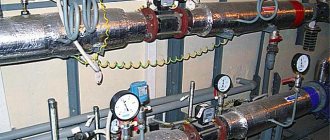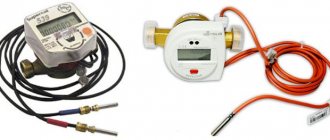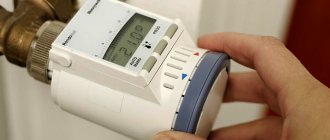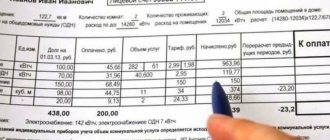Heating tariffs are perhaps one of the most controversial and exciting topics for the population. The main emotion that heat bills usually evoke among citizens is indignation. And this is not surprising, since the quality of the services provided often does not correspond to their cost. It became possible to reduce the degree of tension in the dialogue between providers of housing and communal services and consumers when communal heating meters began to be actively introduced.
According to a law adopted several years ago, such metering devices must be installed in all high-rise buildings, with the exception of those that are in disrepair, as well as houses where the fee for the meter and its installation may exceed the amount of payment for heating for six months.
Like any “new product,” heat meters raise a lot of questions among potential consumers (especially considering the fact that you have to pay for these devices out of your own pocket). First of all, what are their real advantages, how reliable and cost-effective they are, and whether they actually help you save money.
- 2 Disadvantages of collective metering devices
- 3 Meter with ITP - thermal independence
- 4 Classification of common house heat meters
- 5 How is the payment amount calculated?
What does it consist of?
It consists of:
- Temperature sensors.
- Power supplies.
- Calculators that calculate the heat spent on heating a house.
- Flow meters that calculate the volume of coolant in the system.
The parameters collected by the device are automatically sent to the computer, which determines the temperature difference over a certain time interval. The error is no more than 2.5-6% .
Installation procedure
Installation of a common house heat energy meter is a sequential and complex process. First of all, a meeting of the owners of the apartment building is held. This is a mandatory condition, which, moreover, is the basis for further installation. In most cases, the initiator of such a meeting is the management company. If the house is managed by a homeowners association, residential complex or housing cooperative, the meeting is held at the request of the owners based on 10% of their signatures.
Next steps:
- Issuance by the heat supply organization of technical specifications for the installation of a common house meter.
- Development of an installation project and preparation of an estimate by the design organization, taking into account the selected device model and installation location.
- Coordination of the prepared project with the resource supply company, which previously issued the technical specifications.
- Purchase of a heat energy meter approved by the project, which must have a verification stamp.
- Installation work and commissioning of the common house meter, after which the whole process comes to its logical conclusion.
So now you know who should pay for installation
electricity meter, and who should do this anyway. This knowledge will definitely raise your level of household literacy. As for the meters themselves, be sure to buy them from a reputable place. For example, RosSchet provides a wide range of relatively inexpensive metering devices for household needs.
What influences the price range?
There are two decisive factors: manufacturer and type of equipment . Everything is clear with the manufacturer - the cost of the product is directly dependent on the technologies used by the plant. But the type of heat meters directly affects the performance characteristics, and therefore the cost of the product.
The equipment will differ in design features and data reading method . These differences directly affect the ability to install the device on a specific high-rise building.
Affects pricing and service life. Devices that will last from 2 to 4 years less, but the savings, in this case, are questionable. The design, installation and commissioning of the device are not free pleasures, so paying for them every 3-4 years is impractical. Considering that the average payback period for individual devices is at least three years, their purchase becomes economically unprofitable.
How much does a communal heating meter cost?
The answer to the question of how much a common house heat meter costs,
may well shock many city residents and more. Many believe that such a meter is no different from an apartment meter, and accordingly, it should cost either the same or slightly more. However, the cost of a general metering device is usually orders of magnitude higher than that of an apartment meter.
The average price of a communal heat energy meter is about 60 thousand rubles. The figure is very approximate, since the cost depends on several factors, including the specific model and manufacturer. In any case, saving on its purchase is not recommended. This is fraught not only with a high error, and with it an increased payment for energy resources, but also with the occurrence of accidents. This is practically impossible if a good device is installed.
It is noteworthy that residents have several ways to pay for meter installation. First of all, this is a one-time payment if the entire amount is available. Only this option is available to legal entities ordering the installation of a meter. Installment plans for up to 60 months are also available, with the amount repaid in equal monthly installments. There is also a third option - repaying the amount from the capital repair fund. This is possible if the installation of a common house meter is included in the list of works as part of the overhaul.
How much does it cost to install or replace a common house heat meter?
You must understand that the price of the heat meter itself is only a small part of the amount that needs to be spent on turnkey installation. The full price includes the following costs:
- development and further approval of the project;
- purchase of a heat meter, sensors and flow meters;
- purchase of auxiliary materials for installation;
- direct installation of a common house appliance;
- commissioning and commissioning.
In total, taking into account all the points listed above, the complete installation of a common building coolant meter can range from 180 to 250 thousand rubles. Here again, everything depends on the specific house. In some cases, it takes even more to develop and implement a project.
Who installs communal heat meters?
According to Federal Law No. 261-FZ of November 23, 2009 “On energy saving and increasing energy efficiency, and on introducing amendments to certain legislative acts of the Russian Federation,” all consumed energy resources must be accounted for. This is precisely why communal metering devices are installed in apartment buildings. But what if the apartment building still doesn't have a meter? We know who exactly is responsible and must install the communal heating meter
.
In accordance with the Federal Law mentioned above, the responsibility for installing a metering device for an apartment building lies on the shoulders of the apartment owners. According to the government decree, residents must coordinate their efforts and jointly select a company that will sell the equipment and a contractor who will install the communal meter.
On the other hand, from July 1, 2012 onwards, there is no thermal energy meter in an apartment building; the resource supply organization is obliged to take responsibility for its installation. She must also organize the design and installation work.
Types of ODPU
Household metering devices are divided into:
- Tachometer.
- Vortex.
- Electromagnetic.
- Ultrasonic.
The first ones are arranged quite simply. Hence their low market value - from 6,000 to 10,000 rubles . However, to install tachometer models you will additionally need to purchase: a magnetic-mechanical filter, shut-off valves and fittings.
Vortex devices are distinguished by the fact that they are mounted on both vertical and horizontal sections of the system. Equipped with a special battery, which reduces energy consumption. The battery will provide 5 years of trouble-free service life. The average cost of such devices is 15,000 rubles . It should be taken into account that the heat meter is sensitive to contamination, so for stable operation of the unit you will need to purchase a filter.
Electromagnetic varieties are the most economical. Their presence can save up to 50% of money in the consumer’s pocket, but in return you will have to regularly invest in maintaining the DPPU. The presence of impurities in water can lead to breakdowns, and, as a result, incorrect performance of the device and overpayments. The cost of the mechanism is 15,000-17,000 .
Ultrasonic systems are recommended to be installed in new buildings where the heating supply is not clogged with deposits. They take readings by passing an ultrasonic wave through a coolant flow. Current cost is from 15,000 to 48,000 .
Prices are indicated without taking into account the cost of developing design documentation, installation, commissioning and other individual features of residential buildings, which may lead to an increase in the cost of the procedure.
Who is responsible for the communal heat meter in an apartment building?
We will consider the question of who should install a common house meter in an apartment building later, and now we will find out who undertakes to change, repair and otherwise maintain the meter. The answer is simple - the meter is common property, and accordingly, responsibility for its maintenance and further operation lies with the management organization on whose balance sheet the house is located. The same applies to repairs and verification.
You must understand that the management organization is not directly involved in the installation or maintenance of meters. Its task is to allocate finances and order the services of professionals working in specialized companies.
ORDER A SERVICE FROM ACCREDITED COMPANIES
Advantages and disadvantages
common house meter
When justifying the need to install ODPU, the Criminal Code usually gives the following arguments:
- payment for actually consumed heat energy. The presence of a meter allows you to accurately monitor heat consumption and reduce heat energy costs by up to 30%;
- recording leaks in the heating system in order to prevent overpayments for water losses from the central pipeline to the house;
- increasing responsibility for the common territory. By paying for losses from their own pockets, residents of the house are more attentive to the condition of the common property.
Along with the advantages, a heat meter for an apartment building also has disadvantages, which primarily relate to the financial burden on the owners of apartments in multi-apartment buildings. All costs associated with installation and repair of the meter are borne by the residents. The fewer apartments in the building, the higher the payments.
Maintenance of common house heat metering devices
Maintenance of the meter involves maintaining it in working condition. This is achieved as a result of preventive work, such as:
- inspection and elimination of causes affecting wear and breakdown of the control and measuring unit;
- checking the operation of additional equipment;
- operational maintenance and control of metrological accuracy of measurements of the metering device;
- weekly readings for analysis and development of recommendations for maintaining the required temperature.
If a malfunction is detected during the inspection, the device is dismantled, the damage is repaired and reinstalled.
To get a complete picture of maintaining the ODPU in working condition, find out how the MKD heating system is maintained.
Individual heat meters
Installation of an individual heat meter is not necessary. It is installed at the request of the apartment owner, as stated in the Decree of the Government of the Russian Federation dated 05/06/11 No. 354 (clause 3, article 33, section V).
According to the Order of the Ministry of Regional Development dated December 29, 2011 No. 627, individual meters are prohibited from being installed in apartments with vertical wiring.
In addition, in order for the calculations for heating to take into account the readings of apartment meters, they must be installed in each residential and non-residential premises of the apartment building along with a general heat energy meter.
More information about the types of individual heat meters and their purpose is contained in the material “Heat meters for heating in an apartment.”











